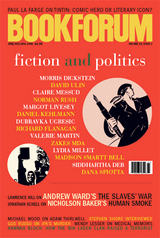
As we were saying, the New York School can be described and redescribed through the coteries that it comprised—this, at least, seems to be the working assumption of recent books on the subject. In its day, the currency of the New York School was gossip; now we read of cliques, of an expanded field, of mutable social frames, or, as in Maggie Nelson’s account, of gender. Women, the New York School, and Other True Abstractions is the promising title of a caprice that moves restlessly among these key terms while acknowledging the contributions made by the women poets whose work the author most likes and respects.
The surest treatments come last. In Nelson’s view of things, Bernadette Mayer, Alice Notley, and Eileen Myles are affiliated not in the way they seek their poetic identities but through their second-generation relations to the established first-generation poets. Mayer’s formation as a poet developed through an affinity for performance, and she finds her brand of inclusive inventory through John Cage and Yoko Ono and, one might add, through the uncensored Beat life. Notley’s emergence, on the other hand, from the magnetic field of Ted Berrigan is delayed by and sustained in family ties to New York School poetics, and Myles’s gaze is fixedly attached to working-class and lesbian terms of identity. It is the varieties of social formation, Nelson believes, that demonstrate that if the word women is an abstraction, the true abstraction would lie in women, the type, being qualified through particular generations and daily lives. Mayer, Notley, and Myles make up the core of Nelson’s last section, which constitutes almost half the book. Here, the author’s discussion is least prone to associative drift and coheres around themes of excess as found in the poetry.
Although Nelson claims that her study is not social but textual, Women, the New York School, and Other True Abstractions is best understood as an informal rendering of the socially inflected rhetoric that attaches to the category women presupposed and/or resisted by the New York School. It is in this sense that “the relationships between effeminate signifiers . . . and actual women” complicate the issue and make relevant the chapter on John Ashbery, Frank O’Hara, and James Schuyler and how homosexual poets create female disguises for themselves and take refuge in worlds that both include and exclude women poets. The weaknesses of the book are most apparent here and in Nelson’s discussion of first-generation New York School poet Barbara Guest and painter Joan Mitchell. The author’s way of keeping her arguments fluid enacts a skittishness as she moves in and between her key terms—terms that, in her usage, elide incommensurable meanings that should have remained distinct. For instance, in asserting Guest to be an abstract poet and Mitchell an abstract painter, Nelson does not articulate the true abstraction by which a particular medium and style signify salient cultural contents. Guest is abstract, but in what sense? Not because she uses color words on occasion, as Nelson says, but rather because a Symbolist poetics coupled with a critical imagination informs a semantic chromaticism that is distributed as a spatial composition. (Yet some would consider Ashbery more abstract owing to the collaged relay of his hyperextended sentences, in which sense drops out as fast as it enters.) Mitchell, included because she is known to have liked poetry, stands in for Abstract Expressionism, and so she is the representative of a very different sort of abstraction, one deriving from the movement’s visceral antiaestheticism. As is typical in Nelson’s treatments, the terms of color and abstraction are mentioned and iterated through the citation of a congeries of sources.
Perhaps, then, the point is that Nelson’s suggestive study is not textual enough. Differences that inadvertently read as repetitions might benefit from a limiting of the varieties of postmodern gestures and drift to develop the textual theory, provisional though it might be.
